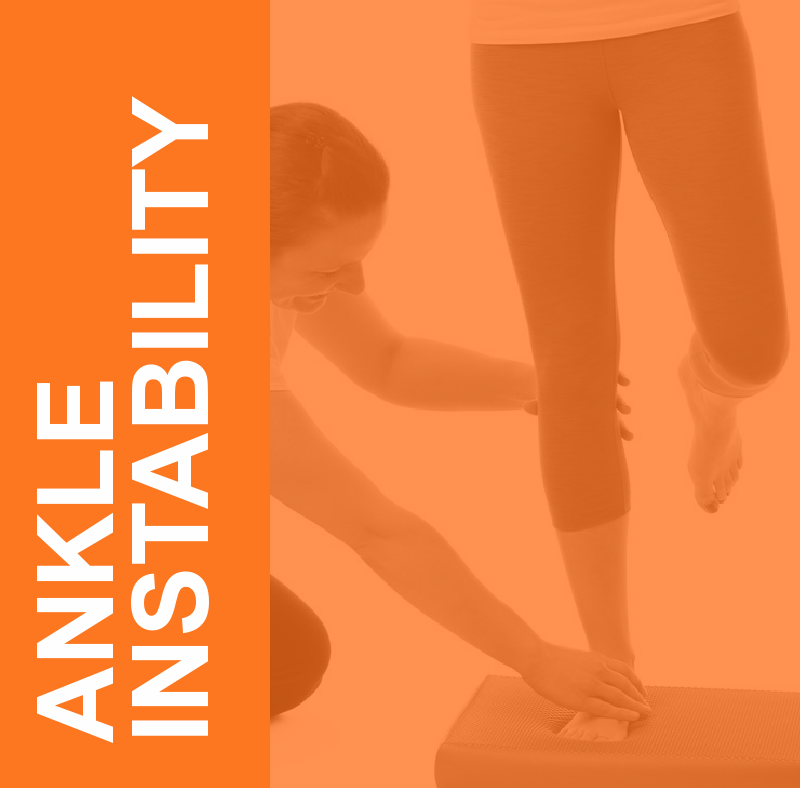
Balance refers to an even distribution of weight on any surface. Adequate balance allows one to remain upright and steady. Balance plays an important role in preventing injuries, maintaining mobility and supporting good posture. Training that specifically addresses balance issues can likewise improve ankle instability following a sprain or other injury.
Correlation between Ankles and Balance
Weak ankles themselves can, in turn, wreak havoc on one’s balance, increasing the risk for future sprains. Given that ankle instability can arise as a function of age just as easily as from an injury, engaging in an exercise regimen focusing on ankle stabilization can often help clients sidestep further problems. Ankle stability as a key component of balance should not be overlooked in the process of rehabilitating an injury.
Living with Chronic Ankle Instability
Chronic ankle instability (CAI) can develop after a sprain or fracture. Typically, about 20% of all acute ankle injuries result in CAI. Joint weakness that accompanies CAI causes the ankle to frequently give way and turn/roll to the side. Swelling, pain, and an overall feeling of unsteadiness round out the condition. Further, a muscular imbalance that was present pre-injury will likely not resolve itself post-injury, and needs to be corrected as part of a rehabilitation program
While chronic ankle instability usually responds well to some combination of anti-inflammatory medications, targeted physical therapy, and occasional bracing, knowing how to recognize the symptoms of potentially weak ankles can help in addressing the problem before it begins to throw off one’s balance and lead to back/hip issues.
This list comprises many of the commonly reported symptoms associated with ankle weakness/instability:
- Persistent soreness in the ankles and feet
- Frequent ankle sprains/fractures/acute injuries
- Ankle supination (high-arches/landing on the outside of the feet)
- Poor sense of balance
- Ankles that “give out” when wearing high-heeled shoes
The Role of Osteoarthritis (OA)
Osteoarthritis, caused by the breakdown of cartilage that covers the bones within a joint, is likely to present in older individuals, but can affect adults of any age. The most common causes of OA include previous injuries to cartilage/ligaments/joints, as well as general “wear-and-tear” of the joints themselves over time (more likely to occur concomitantly with joint dysfunction such as knee hyperextension).
Similar to arthritis in any part of the body, pain, stiffness, and inflammation comprise the most common symptoms of OA. If clients present with a history of ankle injuries, stabilization might facilitate not only strengthening of the joint itself but also aid in overall balance.
Choose Well-Fitting Shoes
Wearing incorrect footwear – too narrow/wide/long/short — can, over time, lead to foot/ankle pain and weakness. Clients and aerobics class participants often ask fitness professionals for advice on footwear. Choosing shoes that fit properly (especially in the toe box) for the individual (rather than polling friends and family!) and have enough support for the chosen activity (running, walking, high-impact aerobics, court sports, etc.) as it relates to the person’s foot mechanics. Those with overpronation issues require arch support while those with oversupination do not. (Ignoring for a moment that these muscle imbalances can and should be addressed and corrected most of the time)
Brain Gain
Improvement of ankle stability not only depends upon overall ligament and muscle/tendon function, but also taps into the powers of the brain. The term proprioception refers to one’s awareness of his body’s location in space at any particular time. The training regimens covered later in this article address both the physical ankle movement as well as the brain-input component.
Score with the Core
Due to inactivity as well as the lifestyle changes that often accompany aging, the core, lower back, and lower extremities muscles tend to weaken over time. Therefore, in conjunction with specific exercises for ankle instability, trainers might choose to include the foundations of basic core and lower body exercises into a client’s regimen. For most individuals, successful balance depends upon one’s ability to stabilize their core muscles.
Exercises To Try to Improve Ankle Instability
In establishing a balance training/ankle strengthening workout routine, always consider the client’s age, frequency/intensity of activity, recreational activites, fitness level, and past injuries. The following exercises begin with the basics and move easily to increasing levels of difficulty.
- Heel Raises (Single & Double Leg): Start clients off by executing this move on a flat surface, using both feet. Once this seems fairly easy, transition to a single leg heel raise, alternating between sides. This exercise works well when standing on a bottom step of a stairway, or on the edge of a step platform. Make sure something stable is close enough to grab, should instability threaten a fall. The eccentric motion enables both the calf muscles and Achilles’ tendon to stretch while simultaneously contracting them. Holding a ball between the heels or wrapping a short resistance band around the ankles will encourage more posterior tibialis involvement—helpful for those with overpronation issues.
- Tandem Balance: This exercise requires a stance of one foot in front of the other, holding the balance point briefly before changing foot orientation. Practice this on a stable surface prior to attempting to balance on a foam pad. For clients eager to take on a challenge, suggest they execute the move with their eyes closed after mastering it with eyes open.
- Tandem Squats: Instruct the client to stand with his feet shoulder-width apart and perform a controlled squat. For phase 2, have the client narrow the stance, increasing the instability and thus the level of difficulty. Once perfected on the floor, try the exercise while standing on a foam pad.
Both the tandem balance and tandem squat moves can shift to the single-leg version when the client is ready.
BOSU for Ankle Instability
Studies have shown that balancing on a BOSU or wobble board typically increases recruitment of ankle-related muscle activity, as compared to balance exercises performed on other surfaces. The BOSU offers the most challenge with regard to inversion-eversion variability, while the wobble board creates a higher number of inversion-eversion direction changes.
- BOSU Lunges, front foot elevated: This exercise involves placing the front foot on the “bull’s eye” of the BOSU and the back foot in a standard single-leg lunge position. Start the client with 10-15 lunges in this position, focusing on a smooth and well-balanced motion. Switch the feet position and repeat the exercise for an additional 10-15 lunges.
- BOSU Lunges, rear foot elevated: This more challenging move has the client placing his rear foot on the “bull’s eye” of the BOSU while the front foot extends into a forward lunge position. Once again, have the client execute 10-15 lunges before switching placement with the opposite foot.
- Heel and Toe Walking: Choose a reasonable distance (the length of the fitness floor, for example) and have client walk forward on his tiptoes. Upon reaching the end of the allotted space, have him turn around and walk back to the starting place on his heels. Remind client to focus on keeping his core muscles engaged throughout the walking, thereby stabilizing the midsection and enhancing balance.
As personal trainers know, the human body thrives best when in motion, further proof of the importance of practicing balance as well as ankle stabilization while executing those functional tasks that comprise Activities of Daily Living (ADL).
References:
www.healthline.com/health/weak-ankles
www.orthocarolina.com/media/improving-balance-for-all-ages-focusing-on-ankle-stability
pubmed.ncbi.nlm.nih.gov/26639734/
pubmed.ncbi.nlm.nih.gov/33344014/
pubmed.ncbi.nlm.nih.gov/27274425/







